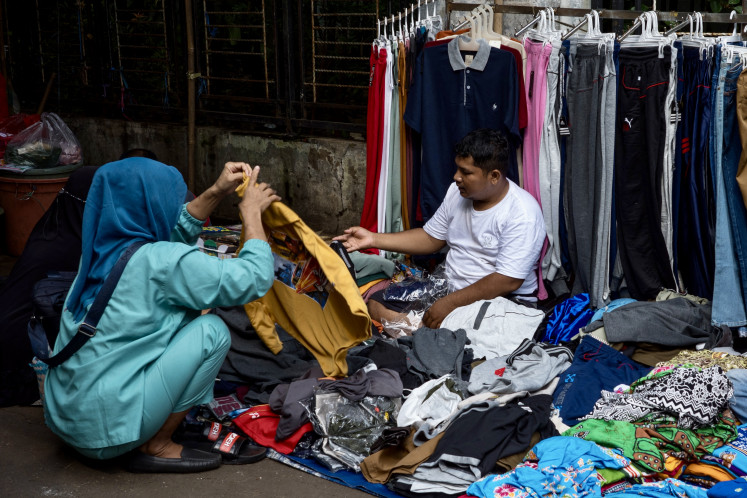Popular Reads
Top Results
Can't find what you're looking for?
View all search resultsPopular Reads
Top Results
Can't find what you're looking for?
View all search resultsThe temperature the human body cannot survive
Scientists have identified the maximum mix of heat and humidity a human body can survive.
Change text size
Gift Premium Articles
to Anyone
Scientists have identified the maximum mix of heat and humidity a human body can survive.
Even a healthy young person will die after enduring six hours of 35-degree-Celsius heat when coupled with 100 percent humidity, but new research shows that the threshold could be significantly lower.
At this point sweat, the body’s main tool for bringing down its core temperature, no longer evaporates off the skin, eventually leading to heatstroke, organ failure and death.
This critical limit, which occurs at 35 degrees of what is known as “wet-bulb temperature”, had only been breached around a dozen times, mostly in South Asia and the Persian Gulf, Colin Raymond of NASA’s Jet Propulsion Laboratory told AFP.
None of those instances lasted more than two hours, meaning there had never been any “mass mortality events” linked to this limit of human survival, said Raymond, who led a major study on the subject.
But extreme heat does not need to be anywhere near that level to kill people, and everyone has a different threshold depending on their age, health and other social and economic factors, experts say.
For example, more than 61,000 people are estimated to have died due to heat last summer in Europe, where there is rarely enough humidity to create dangerous wet-bulb temperatures.
But as global temperatures rise – July was confirmed on Tuesday as the hottest in recorded history – scientists warn that dangerous wet-bulb events will also become more common.
The frequency of such events had at least doubled over the last 40 years, Raymond said, calling the increase a serious hazard of human-caused climate change.
Raymond’s research projected that wet-bulb temperatures would “regularly exceed” 35 degrees at several points around the world in the coming decades if the world warmed 2.5 degrees above preindustrial levels.
‘Really, really dangerous’
Though now mostly calculated using heat and humidity readings, wet-bulb temperature was originally measured by putting a wet cloth over a thermometer and exposing it to the air.
This allowed it to measure how quickly the water evaporated off the cloth, representing sweat evaporating off skin.
The theorized human survival limit of a wet-bulb temperature of 35 degrees represents 35 degrees of dry heat as well as 100 percent humidity, or 46 degrees at 50 percent humidity.
To test this limit, researchers at Pennsylvania State University in the United States measured the core temperatures of young, healthy people inside a heat chamber.
They found that participants reached their “critical environmental limit”, or when their body could not stop their core temperature from continuing to rise, at a wet-bulb temperature of 30.6 degrees, well below the previously theorized 35 degrees.
The team estimated that it would take between five and seven hours before such conditions would reach “really, really dangerous core temperatures”, Daniel Vecellio, who worked on the research, told AFP.
Most vulnerable people
Joy Monteiro, a researcher in India who last month published a study in Nature looking at wet-bulb temperatures in South Asia, said most deadly heat waves in the region were well below the 35-degree wet-bulb threshold.
Any such limits on human endurance were “wildly different for different people”, he told AFP.
“We don’t live in a vacuum, especially children,” said Ayesha Kadir, a pediatrician in the United Kingdom and health advisor at Save the Children.
Small children were less able to regulate their body temperature, putting them at greater risk, she said.
Older people, who have fewer sweat glands, are the most vulnerable.
Nearly 90 percent of the heat-related deaths in Europe last summer were among people aged over 65.
People who have to work outside in soaring temperatures are also more at risk. Whether or not people can occasionally cool their bodies down, for example in air-conditioned spaces, is also a major factor.
Monteiro pointed out that people without access to toilets often drank less water, leading to dehydration.
“Like a lot of impacts of climate change, it is the people who are least able to insulate themselves from these extremes who will be suffering the most,” Raymond said.
His research has shown that El Niño weather phenomena have pushed up wet-bulb temperatures in the past. The first El Niño event in four years is expected to peak toward the end of this year.
Wet-bulb temperatures were also closely linked to ocean surface temperatures, Raymond said.
The world’s oceans hit an all-time high temperature last month, beating the previous 2016 record, according to the European Union’s Climate and Health Observatory.










